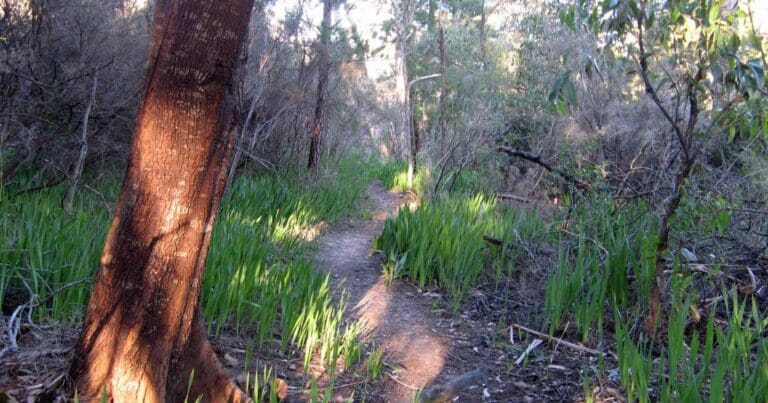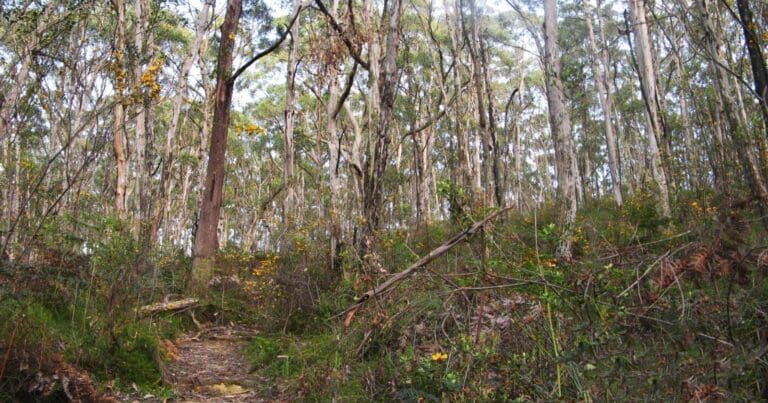Hike at a Glance
Max elevation: 458m
Min elevation: 314m
Total Ascent: 325m
Hike overview
The Aldgate Valley Nature Walk is a scenic 14km return trail (7km one way) traversing the Adelaide Hills between Mylor and Aldgate. Rated as moderate difficulty (grade 3), it takes approximately 3.5 hours to complete.
This walk showcases the efforts of the Aldgate Valley Landcare Group and other community organisations in restoring and connecting fragmented patches of native bushland across public and private land. It serves as a testament to the ongoing battle against weeds and other threats to the local ecosystem.
The trail winds through the Aldgate Valley, where visitors can spot southern brown bandicoots – small marsupials reintroduced to their natural habitat. The surrounding bushland provides a haven for diverse wildlife, including kangaroos, possums, echidnas, koalas, and numerous bird, reptile, and amphibian species. Over 150 native plant species line the path, from delicate orchids to towering Candlebark gums, offering a floral display throughout the year with a peak in spring. Autumn brings the opportunity to witness a spectacular display of fungi.
Beyond its scenic beauty, the Aldgate Valley Nature Walk serves as a reminder of the importance of habitat corridors. By connecting isolated bushland fragments, the walk allows wildlife to move freely between areas, promoting a healthier ecosystem. Hikers will pass by private properties participating in bush regeneration efforts. It's important to remember these areas are a work in progress, slowly recovering from past disturbances.
Gallery
Got some great shots from this hike? Upload your photos here to inspire others and show off the beauty of the trail!
Click to view form >>
Submitting your photos doesn’t mean you lose ownership. You can be credited for your contributions, and you can request removal at any time.
Content use
Please don’t copy GPX files or content from this site to AllTrails or other platforms. Each trail has been personally mapped, documented, and refined to support Australia’s bushwalking and hiking community. While some details come from land managers, every listing reflects significant personal effort. This is a free, community-driven initiative—your respect helps keep it that way.
Walk map and GPX file
Max elevation: 458 m
Min elevation: 314 m
Total climbing: 325 m
Total descent: -325 m
Getting there
Getting to the trailhead: Aldgate Valley Reserve.
The Aldgate Valley Nature Walk begins at the Stock Road Carpark, located next to the Mylor Tennis and Netball Club in the Southern Mount Lofty Ranges. This carpark is situated roughly 15km southeast of Adelaide, making it an easily accessible escape from the city. As this is a return hike, you can walk in any direction.
Closest towns to this walk: Aldgate, Bridgewater, Crafers, Mylor, Stirling
About the region
The Aldgate Valley, a picturesque gem nestled within the Adelaide Hills, beckons nature lovers with its scenic beauty and rich biodiversity. Located roughly 15km southeast of Adelaide in the Southern Mount Lofty Ranges, the valley offers a tranquil escape featuring pockets of native bushland. These pockets are cleverly linked by corridors, creating a vital network for wildlife to move freely. The bushland itself provides a haven for a variety of Australian animals, including the shy southern brown bandicoot, the iconic kangaroo, playful possums, fascinating echidnas, and even the occasional koala sighting.
Hikers and cyclists can explore the heart of the valley via the scenic Aldgate Valley Nature Walk. This 7km (one way) or 14km (return) journey allows visitors to immerse themselves in the natural beauty. For those seeking post-adventure refreshments, cafes are conveniently located at both ends of the trail. The Aldgate Pump Hotel and cafes in Aldgate offer a welcoming atmosphere, while the Harvest Cafe in Mylor beckons with delicious treats. Families with young children will also appreciate the playground near the Mylor trailhead, making it a perfect spot for a post-walk rest.
Similar walks nearby
Looking for more walks in or near Aldgate Valley Reserve? Try these trails with a similar difficulty grade.
Track grade
Grade 3 (Moderate) - Walks for Most Fitness Levels: Grade 3 on the AWTGS represents moderate walking tracks. These are ideal for walkers with some fitness who are comfortable with some hills and uneven terrain. While suitable for most ages, some bushwalking experience is recommended to ensure a safe and enjoyable experience. Tracks may have short, steep hill sections, a rough surface, and many steps. The total distance of a Grade 3 walk can be up to 20 kilometers.
Explore safe
Plan ahead and hike safely! Carry enough water, pack layers for changing conditions, and bring safety gear like a torch, PLB, and reliable communication device. Check official sources for trail updates, closures, and access requirements, and review local weather and bushfire advice. Most importantly, share your plans with someone before you go. Being prepared makes for a safer and more enjoyable hike! Stay Safe, Explore More, and Always #ExploreSafe.
Packing checklists
What you carry in your pack depends on factors like weather, terrain, and your adventure type. Not sure what to bring? My free planning, food, and packing checklists are a great starting point, covering day hikes, overnight trips, and multi-day adventures. Use them to customise your kit and always prioritise safety.
Let someone know
Before heading out, take a moment to fill out your trip intentions form. It’s a quick way to share your hike details with family or friends. If something goes wrong, they can notify emergency services, ensuring a faster response and peace of mind. Stay safe and enjoy your adventure
Suggest an edit
Spotted a change on this trail? Maybe there are new features, the route has shifted, or the trail is permanently closed. Whatever the update, I’d love your input. Your feedback helps fellow hikers stay informed and ensures that our trail info stays fresh and reliable.
Acknowledgement of Country
Trail Hiking Australia acknowledges the Traditional Owners of the lands on which we hike and pay respects to their Elders, past and present, and we acknowledge the First Nations people of other communities who may be here today.






